Why Problem Root Causes Matter
In every business, complexity is the quiet killer. It creeps in as jargon, bloated strategies, and layered processes that make simple goals feel unreachable. I’ve seen teams bury good ideas under unnecessary weight. I’ve seen founders second-guess themselves because “best practices” got in the way of what’s obvious. That’s where I come in.
I exist to cut through that noise.
The real pain I solve is decision fatigue caused by too many options, too little clarity, and an over-reliance on convoluted frameworks. My work matters because it restores confidence, speed, and sanity. I don’t promise magic. I promise momentum. Simplicity, when done right, is not dumbing things down, it’s smart business. And most of the time, the best path forward is the one hiding in plain sight.
I believe that if something isn’t obviously useful, it probably isn’t.
That belief isn’t just philosophy, it’s a discipline rooted in the principles of Occam’s Razor, The 5 Whys, Lean Thinking, and the legendary “Obvious Adams” framework. These aren’t buzzwords. They’re working tools for stripping away fluff and surfacing what actually drives impact.
My job is to help you stop overthinking and start making.
How I Approach Problem Root Cause Analysis
My approach is ruthless in a good way. I use a mix of critical analysis and radical simplicity to diagnose business problems and eliminate waste.
First, I ask: What are we really trying to solve here? You’d be surprised how often people can’t answer that clearly. So we get clear, together. Then I start challenging every layer of complexity until we get to the essential. I rely on tools like:
- The Simplicity Cycle: To identify what’s actually valuable vs. what’s just noise.
- Eisenhower Matrix: To separate urgent from important and kill busywork.
- Critical Path Analysis: To isolate what actually moves the needle.
- SWOT + The 5 Whys: To map the territory and dig to the root causes fast.
I also check in during every project to make sure the team hasn’t drifted back into complexity. If it’s not serving the goal, it’s gone. If it’s slowing things down, we fix it. If it’s obviously working, we scale it.
This isn’t about being minimal for minimalism’s sake. It’s about being effective — and freeing people up to do what matters.
What I Deliver
Here’s what people get when they work with me:
- Problem Simplification: I take messy challenges and extract the core issue. Clients walk away knowing exactly what to solve and how to start.
- Simplicity Audits: I assess strategies, systems, and proposals through the lens of the Five Tests of the Obvious. What’s clear stays. What’s clutter goes.
- Experiment Design: I help teams test solutions quickly and simply, with just enough structure to move fast and learn faster.
- Ongoing Course Correction: I don’t just give answers and walk away. I stay engaged, making sure simplicity is sustained as the work evolves.
Ultimately, I deliver clarity. And clarity creates action.

strategist. Simplifying complexity so
businesses can move faster.